GameCube accessories
This article has multiple issues. Please help improve it or discuss these issues on the talk page. (Learn how and when to remove these messages)
|
GameCube accessories include first-party releases from Nintendo, and third-party devices, since the GameCube's launch in 2001.
First-party and licensed
[edit]Controllers
[edit]GameCube controller
[edit]
The GameCube controller was released alongside the console and comes bundled with every unit. Standard colors include Indigo, Black, Spice (orange), Emerald Blue (green, only available in Japan), Platinum, Indigo-clear, and Pearl White (only available in Europe). There are also limited edition controllers available such as a split blue and red, with the Mario "M" logo replacing the regular GameCube logo seen on standard controllers (there have also been green and blue Luigi "L" controllers and similarly yellow and pale blue Wario "W" controller). There are also specially colored controllers bundled with systems, such as the Mobile Suit Gundam Edition (Red), Symphonic Green Edition (Turquoise Green) and the Final Fantasy Crystal White Edition. The controller can also be used to play certain games on the Wii system and as a result in 2008 Nintendo issued a white GameCube controller (Japan only). This controller also features a white 3 m/10 ft long cable, rather than the standard 2 m/6.5 ft black cable.
In 2014, there was a re-release of the Standard GameCube controller coinciding with the release of Super Smash Bros. for Wii U. It was very limited and is the same as the original controller other than replacing the GameCube logo with the Super Smash Bros. logo instead. It was available in Black or White. A similar controller was released on November 2, 2018 to coincide with the release of Super Smash Bros. Ultimate for Nintendo Switch, featuring a simpler design of the Super Smash Bros. logo on it and was available only in Black. Both re-released controllers featured a longer 3 m/10 ft cable.
WaveBird Wireless Controller
[edit]
The WaveBird Wireless Controller is an RF-based wireless controller based on the same design as the standard controller. It communicates with the GameCube system wirelessly through a receiver dongle which connects to one of the system's controller ports. It is powered by two AA batteries. As a power-conservation measure, the WaveBird lacks the rumble function of the standard controller. The WaveBird controller was available in most regions only in light gray and platinum colors. In Japan two limited edition WaveBird models were released through Club Nintendo: 1,000 Special Edition Gundam "Char's Customized Color" WaveBirds (two-toned red with the Neo-Zeon logo) to coincide with the Japan-only GameCube release of Mobile Suit Gundam: Gundam vs. Z Gundam,[1] and a "Club Nintendo" WaveBird (white top with light blue bottom and Club Nintendo logo)
DK Bongos
[edit]
DK Bongos (Japanese: タルコンガ, Hepburn: Tarukonga) were designed for use with the music games Donkey Konga, Donkey Konga 2, and Donkey Konga 3, and the platformer Donkey Kong Jungle Beat, all of which were packaged with DK Bongos. A racing game, DK Bongo Blast, was also set to use the peripheral, but the GameCube version was canceled, and the game eventually released on the Wii without Bongo support as Donkey Kong Barrel Blast. Players hit the controller like a pair of bongo drums. The controller has an analog sound-sensor module between the two drums to detect clapping.
Due to the uniqueness of the peripheral, the bongos were utilized by various games long after their release. They are compatible with the 2018 Taiko no Tatsujin: Drum 'n' Fun! via the Gamecube Controller Adapter for Nintendo Switch.[2] Several indie games were also designed around them, such as Beat Nebula (2016),[3] Squatbot (2018),[4] and Beat Bull (2022).[5] They are commonly used in challenge runs as a non-standard control method, such as being used in 2020 to beat Sekiro: Shadows Die Twice.[6]
Action pad
[edit]The Action Pad was included with Dance Dance Revolution: Mario Mix. It has 4 arrows.
Beat Pad
[edit]The Beat Pad was made by Mad Catz and officially licensed by Nintendo. It was included with the game MC Groovz Dance Craze and sold separately. It has 8 arrows.
ASCII keyboard controller
[edit]
The ASCII keyboard controller resembles a standard GameCube controller pad stretched to accommodate an alphanumeric keyboard in the center. The keyboard requires the use of two controller ports and contains both Latin and Japanese hiragana characters. It was developed for use with Phantasy Star Online Episode I & II.
Hori Game Boy Player Controller
[edit]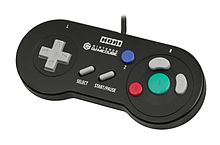
The Hori Game Boy Player Controller comes in the colors Indigo and Jet Black, in the shape of a SNES control pad. It does not include the Control Stick or C-Stick, and the R and L buttons lack a range of pressure sensitivity; thus, only uses the D-pad for movement and the usual buttons for playing. Although meant for the Game Boy Player, it can be used with certain 2D GameCube games, such as Alien Hominid, Capcom vs. SNK 2 EO, Mega Man Anniversary Collection, Sonic Mega Collection, Sonic Gems Collection, or a few 3D GameCube games that support D-pad movement, like Crash Bandicoot: The Wrath of Cortex and Mortal Kombat: Deadly Alliance.
Hori Fighting Stick
[edit]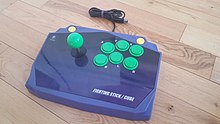
Hori built an arcade stick that was licensed by Nintendo. The controller does not support control stick or C-stick functionality. The system treats the stick like the D-pad on a standard controller, so it is ideal for fighting games and shoot 'em ups. A standard variant has a purple faceplate, and the other has a SoulCalibur II faceplate.
Logitech Speed Force Racing Wheel
[edit]The Logitech Speed Force Racing Wheel is an officially licensed force feedback steering wheel made exclusively for the GameCube. It is supported by a number of games, including F-Zero GX, R: Racing Evolution, Mario Kart: Double Dash, Burnout 2, and the Need for Speed series, among others. An optional accessory pack includes foot pedals and a lap attachment.
Audio/Video cables
[edit]Compatibility with various A/V cables vary by region and console model.
RF Switch/modulator
[edit]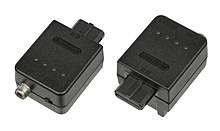
The RF Switch/modulator is for older televisions predating composite audio/video ports. It is identical to and compatible with earlier Nintendo RF modulators. It has the Nintendo 64 RF modulator cased in GameCube packaging, and its RF switch is the same as the original Nintendo Entertainment System and Super NES.
Composite video cable
[edit]
The composite video cable, or AV cable, is included with the GameCube. It provides clearer and sharper picture quality and audio than an RF Switch. It is identical to earlier A/V cables. It carries dual-channel (stereo) audio and composite video at 576i/50 Hz (PAL) or 480i/60 Hz (NTSC/PAL60). PAL consoles come with a composite to Scart adaptor in European territories to allow Composite input via a Scart port (ScartAV).
S-Video cable
[edit]The S-Video Cable provides a better quality picture than composite cables, although not up to that of the Component or RGB Cables. Identical to earlier Nintendo (N64 and the original model SNES) S-Video cables and compatible with their respective consoles, it carries dual-channel (stereo) audio and s-video at 480i/60 Hz (NTSC). This cable is only compatible with NTSC GameCubes.
RGB SCART cable
[edit]The RGB SCART cable provides a better quality picture than RF, composite or S-Video cables. It utilizes the SCART connector standard and is sold in Europe only. Operates at 576i/50 Hz or 480i/60 Hz. This cable is only compatible with PAL GameCubes.
Component video cable
[edit]
The Component Video Cable provides video quality superior to that of the RF modulator, composite video cable and s-video cable and is equal in quality to RGB Scart (at 576i/50 Hz or 480i/60 Hz). It enables progressive scan (480p/60 Hz) in supported games which is not possible with most other cables. The Japan-only D-Terminal cable also has this feature. PAL released games lack progressive 480p output. The connector plugs into the Digital AV port rather than the Analog AV port used by other cables and contains a Macronix CMPV-DOL video chip (a digital-to-analog converter). This converts the YCBCR digital video coming from the digital port to the YPBPR analog format used by component video equipment. CMPV-DOL's reconfigurability allows it to carry out unusual functions such as YCBCR to RGBHV conversion, but it cannot take advantage of the digital audio from the console's digital port. This means that a separate cable, such as the system's standard A/V cable, must also be connected to the Analog AV port in order to transmit the audio signal.
This cable is only compatible with DOL-001 models of the GameCube, as Nintendo chose to omit the Digital AV port in subsequent models of the console.
D-Terminal cable
[edit]The D-Terminal Video Cable is identical to the Component Video Cable but for its connector, which is a more popular format in Japan. Like the component cable, it may be used to output video in 576i/50 Hz, 480i/60 Hz or 480p/60 Hz, uses the Digital AV port, needs a separate analog cable for audio, and is only compatible with DOL-001 models of the GameCube.
Other
[edit]Memory cards
[edit]
The GameCube's memory card options comprise three distinctive capacities, with each exhibiting a different color variant. Specifically, these card models include the Memory Card 59 in grey, boasting a storage capacity of 4 Mbit or 512 KB; the 251 model in black with a capacity of 16 Mbit or 2 MB; and the 1019 model in white, exhibiting the largest storage capacity of 64 Mbit or 8 MB. The maximum capacity for a single card is 127 files. Each card necessitates five blocks of system data, denoting that the physical dimensions of the cards are either 64, 256, or 1024.
Certain games, such as Animal Crossing and Pokémon Colosseum, require very large save files and were originally bundled with a Memory Card 59 with game-themed stickers. Pokémon Box: Ruby and Sapphire was bundled with an exclusive translucent red and blue colored Memory Card 59, with matching stickers. Club Nintendo members in Japan briefly had the opportunity to exchange points for a white and blue Memory Card 251, with club themed stickers.
GameCube-Game Boy Advance cable
[edit]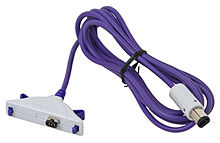
The GameCube-Game Boy Advance cable was used for games that support connectivity between the GameCube and the Game Boy Advance (bundled with some games). The cable also worked with the Wii and the Game Boy Advance SP.
Modem and Broadband adapters
[edit]
The Modem adapter and Broadband adapter, models DOL-012 and DOL-015 respectively, were developed by Nintendo for Internet and LAN networking. Only eight games support the devices. Both connect to Serial Port 1.
Game Boy Player
[edit]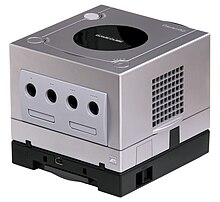
The Game Boy Player allows Game Boy games to be played on the television, using either a GameCube controller or a connected Game Boy Advance which connects to the controller port.
Microphone
[edit]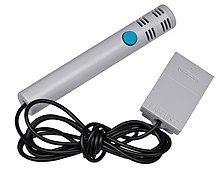
The Microphone plugs into one of the memory card slots. The Microphone functions with Mario Party 6, Mario Party 7, Karaoke Revolution Party, Odama, Chibi-Robo!, and Densetsu no Quiz Ou Ketteisen. Odama includes a clip to attach the microphone to the controller. Commands are issued when users hold the X button on the controller. The microphone bundled with Mario Party 6 and 7, Odama, and Densetsu no Quiz Ou Ketteisen is grey, and the one with Karaoke Revolution Party is black.
ProDG
[edit]ProDG is an officially licensed development tool for the GameCube.[7]
Carrying cases
[edit]Several official carrying cases for the GameCube and discs have various size and shapes. They were all manufactured by A.L.S. Industries INC and use an NGC model number.[8]
Pedometer and walking pad controller
[edit]A pedometer and walking pad controller was bundled with the Japanese pilgrimage simulation game Ohenro-San: Hosshin no Dojo.[9][10][11][12][13][14][15]
Third party
[edit]Datel
[edit]Action Replay
[edit]Action Replay is a cheat device made by Datel, allowing input of codes that modify the game. A FreeLoader is included with the software. It contains a boot disc with the codes and startup, and a dongle that connects into memory card slot B and stores 1 or 2 memory blocks. Its save file can be copied onto other memory cards, as well, allowing for one person to share their codes with someone who may have an earlier version of Action Replay, or the sharing of custom-made codes.
Action Replay MAX is the same but its dongle has more storage, 64 Mb card with 1019 blocks.
Freeloader
[edit]FreeLoader disables the regional lockout in the GameCube, allowing games from any region (PAL, NTSC, NTSC-J, etc.) to be played on a console from any region. Some Freeloaders are compatible with the Wii, allowing out of region GameCube games on it (later blocked by system updates).
Advance Game Port
[edit]The Advance Game Port is Datel's version of the Game Boy Player. This dongle connects to memory card slot B and is booted up with the included boot disc. Some models have code generators for built in cheat devices. The advantage is that no removal of plates on the bottom, nor tools, are needed to install it. There are a few problems with the audio and video framerate and it is not 100% compatible with GBA games. Unlike the Game Boy Player, it is compatible with the Wii.
Powerboard
[edit]The Powerboard is a USB keyboard by Datel with a GameCube adapter for the online Phantasy Star games and for Action Replay codes. The keyboard without the adapter was released for the PlayStation 2.
MAX drive
[edit]The MAX Drive consists of a dongle, USB cable, and a PC software disc, which allows the user to upload saved games from a memory card to a PC, to be stored there or sent over the Internet.
MAX Memory
[edit]The MAX Memory is a 128 Mb dongle by Datel that contains up to 2048 blocks of data.
MAX Media Player
[edit]The MAX Media Player allows videos and other downloadable media to be played on a GameCube. Movies and media are transferred to the included 1 GB Micro SD card, that is then inserted into a dongle for the GameCube and into memory card slot B. The kit also includes boot disc, SD adapter (for use on the Wii in GameCube mode), USB micro SD Card adaptor, and a small remote control for easy management.
Other companies
[edit]Afterglow controller
[edit]The Afterglow Controller was produced by Pelican Accessories. It's known widely for being a largely unsuccessful addition to the Gamecube ecosystem.
Battery Pack
[edit]Intec produced a battery pack which can be attached securely to the bottom of a GameCube, offering about two hours on a charge. It was designed to work with an LCD screen.
Controller extension cables
[edit]Various companies have produced controller extension cables for the GameCube.
Hip Screen
[edit]The Hip Screen is a controller made by Hip Gear that features a small full color LCD screen as TV. Its size was roughly that of the Game Boy Advance, so games that had very fine text could not be well read on it.
LCD Screens
[edit]Various manufacturers (such as Intec, Mad Catz, and Zenith Electronics) have produced LCD screens that can snap onto the GameCube, allowing the console to be used without a separate television screen. Such screens are powered by the GameCube's power supply and connects to the console's digital AV outlet. These snap-on LCD screens make the GameCube more portable.
Pelican Bongos
[edit]The Pelican Bongos were made by Pelican Accessories and resemble DK Bongos. They are a much darker color and have a 10% larger surface than the Nintendo bongos.
PlayStation controller adapters
[edit]
Various adapters allow PlayStation and PlayStation 2 controllers to be used on the GameCube, including:
- Innovation INNOV3102 Controller Adaptor
- Mayflash Cube Joy Box[16]
- Hais GameCube Smart Joy (HS2125C)
SD media launcher
[edit]The SD Media Launcher allows homebrew games to be played on the GameCube without modifying the console. The dongle connects into the memory card slot and contains a removable SD card which holds the games. It has a boot disc for starting the unit up, a 1 GB SD card, and an SD card adapter for uploading games from a PC to the GameCube.
SmashBox Controller
[edit]In the mid 2010s, Dustin Hoffer of Hit Box designed the SmashBox controller. Specifically designed for competitive play of Super Smash Bros. Melee, it replaces the GameCube controller's analog stick with a button layout. It may allow more precise and rapid input, though it has a steeper learning curve than the traditional controller, and puts less stress on the hands. After a half year test period, various prominent tournament organizers prohibited the SmashBox controller and similar alternative controllers in high-level tournaments for the foreseeable future.
VGA cable
[edit]The VGA Cable is a modified component or d-terminal cable. It allows the GameCube play on a standard computer monitor in 480p.[17]
GCVideo
[edit]GCVideo is an open-source video solution created by Unseen that uses the Digital AV port (DOL-001 only) to output a digital video signal via HDMI or an analog signal via an component cable.[18] Anyone can produce an adapter that uses the GCVideo firmware because it is open-source software. Many companies have made solutions that use the software to output an HDMI signal that can be used with any modern TVs. It also can handle audio, sending a digital 16-bit PCM audiostream. This includes the GCHD Mk-II by EON Gaming[19] and the Carby by Insurrection Industries.[20] Both do not require modification of a GameCube and can simply be plugged into the Digital AV port.
References
[edit]- ^ Gantayat, Anoop (November 18, 2004). "Special Wavebird For Japan". IGN. Retrieved 2007-04-14. [verification needed]
- ^ Doolan, Liam (2018-07-31). "Random: DK Bongos Are The Perfect Substitute For Hori Taiko Drum Controller". Nintendo Life. Retrieved 2023-02-02.
- ^ McFerran, Damian (2016-11-08). "Random: PC Indie Title Gives You A Reason To Dust Off Those Donkey Konga Bongos". Nintendo Life. Retrieved 2023-02-02.
- ^ Cunningham, James (2018-10-02). "The Boston Festival of Indie Games Overview 2018, Part 1". Hardcore Gamer. Retrieved 2023-02-02.
- ^ Norman, Jim (2022-08-31). "Random: This New PC Platformer Is Designed To Be Played With DK Bongos". Nintendo Life. Retrieved 2023-02-02.
- ^ Watts, Rachel (2020-07-28). "Is Sekiro a rhythm game? We asked the player who beat it on Donkey Kong bongos". PCGamesN. Retrieved 2023-02-02.
- ^ "SNSYS: ProDG". Archived from the original on November 13, 2006.
- ^ "Moeroshop - L'entreprise". moeroshop.net.
- ^ "お遍路さん" [Pilgrim] (in Japanese). Archived from the original on 2 April 2003.
- ^ "お遍路さん" [Pilgrim]. Translated by Google Translate.
{{cite web}}: CS1 maint: others (link) - ^ "Samurai Nintendo : GameCube news archives". www.samurainintendo.com.
- ^ "Ohenro-San: Hosshin no Dojo - IGN" – via www.ign.com.
- ^ "Ohenro-San Box Shot for GameCube - GameFAQs". gamefaqs.gamespot.com.
- ^ "Ohenro-San Box Shot for GameCube - GameFAQs". gamefaqs.gamespot.com.
- ^ "Pilgrimage [Pedometer Set]". Playasia.
- ^ "GameCube Joy Box-Specially designed for PSX/PSX2 official Joypad/ PS2 DDR Supported now!!!". Mayflash. Archived from the original on 2010-07-27. Retrieved 2010-08-16.
- ^ "How to make NGC's RGB(VGA) Cable". Retrieved 2010-08-16.
- ^ Korb, Ingo (2020-08-12), ikorb/gcvideo, retrieved 2020-08-12
- ^ "EON Black GCHD MKII Video Adapter - Nintendo Gamecube - Dual Output - No Lag". CastleMania Games. Retrieved 2020-08-12.
- ^ "CARBY". Insurrection Industries. 2019-01-26. Retrieved 2020-08-12.
